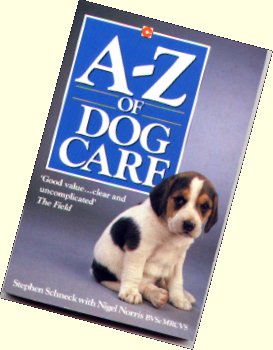Have you checked your club's first aid kit
lately?
 Make it your New Year's
resolution to check your Club's First Aid Kit. It only makes sense for all agility clubs to
have a first aid kit in a water-tight box, clearly marked and kept in a safe place. After all,
it could be you or your dog that needs help. Better safe than sorry. Make it your New Year's
resolution to check your Club's First Aid Kit. It only makes sense for all agility clubs to
have a first aid kit in a water-tight box, clearly marked and kept in a safe place. After all,
it could be you or your dog that needs help. Better safe than sorry.
 Basic first aid kit Basic first aid kit
According to The Queen Mother Hospital for Animals at The Royal Veterinary College,
the basic materials you need in a canine first aid kit would include:-
- 4
x rolls of 2in. (5cm) roller bandage
- 4 x rolls of 2in. (5cm) elastoplasts
- Sharp-edged, blunt-pointed scissors
- Caustic pencil for broken nails
(If you cannot get this, pushing a bar of soap into the nail, stops bleeding.)
- Antiseptic solution e.g. Savlon, Dettol, Roccal
(A teaspoon of salt in a pint of boiling water will do the job.)
- A packet of cotton wool
- Micropore
- Tweezers (A pair of forceps)
- Rectal thermometer
Thanks to Rachael Fensame V.N. at the Royal Vet College
for her help.
Additional items

To that add:-
- Bottle of 20 vol, hydrogen peroxide
- Razor blade
- Codeine tablets
- Paracetamol tablets
- Packet of cotton buds
- Crystal washing soda (emetic)
- Milk of magnesia
- Table salt
- Eyedropper
- Copy of A-Z of Dog Care by Stephen Schneck with Nigel
Norris BVSc MRCVS or similar book
- Local vet's telephone number
You can get most of these items from your local chemist. But remember that a first aid kit
deals only with cuts and bruises and isn't really appropriate for collapsing dogs.
Thank you to S. Trewin at Sheil & Land for permission to
use quotes from A-Z of Dog Care by Stephen Schneck with Nigel Norris BVSc MRCVS.
Super Deluxe First Aid Kit
 Dr Bradshaw's Larger than a Bread Box First Aid Kit
Dr Bradshaw's Larger than a Bread Box First Aid Kit
At K9 First Aid Seminar sponsored by the Dog Owners Training Club of Lynchburg, Virginia
(USA) two years ago, Dr. Bradshaw made some suggestions for additional things to include in a
canine first aid kit for home and travel. Here are some things he recommended. They include a
plastic Rubbermaid type tub and the following:-
- Telfa Pads
- Gauze Pads
- Roll Gauze
- Cling Gauze
- Hand Towel
(to be used for additional padding over the wound before wrapping or splinting.)
- Vet wrap
- Cast Padding
- Tongue blades for splinting
- Sterile Petroleum Jelly
- Safety Pins
- Sterile Flush Solution (Lens Cleaning Solution 1%
Saline)
- Latex gloves
(to wear when inducing vomiting)
- Benedryl (or Chlor-Trimiton) tablets
- Activated charcoal
- Fluoride toothpaste
(For bee/ant stings, he recommended carrying a small tube of Fluoride toothpaste which can be
dabbed on for instant relief.)
- Mylanta
- Large beach towel or blanket which can be used as a
stretcher for large dogs
- Solar blanket
(to keep a dog warm who may be going into shock)
- Nylon muzzle to fit your dog
- Flashlight
- Sharp knife
- Ice bag/pack
For a holistic approach see
An Alternative First Aid Kit by Frances
Gavin.
Homeopathic First Aid
 For many years,
classical homeopathy has been recognised as a safe and effective alternative to treating
ailments, serious and minor in humans and animals alike. Homeopathic remedies are made in
different strengths but generally speaking the 6c potency is recommended for treatment of dogs. For many years,
classical homeopathy has been recognised as a safe and effective alternative to treating
ailments, serious and minor in humans and animals alike. Homeopathic remedies are made in
different strengths but generally speaking the 6c potency is recommended for treatment of dogs.
How to give treatment
All medicines should be given in tablet form unless otherwise stated. The ideal method of
administration is to empty the remedy directly on the tongue when the animal (or person) is
not feeding. For this purpose, the tablet can be crushed to a powder or, if the dog
resists, concealed in a small piece of bread or meat or the crushed tablet can be dissolved in
milk or drinking water.
For best results, do not handle the tablets directly. Use
the cap as a dispenser. When necessary, crush the tablets between two spoons.
Storage
Remedies should be stored in a cool, dry place away from light and strong-smelling substances
such as camphor and disinfectants etc. Stored properly, medicines will keep their potency for
many years.
Dosage
Dosage in acute conditions may require frequent repetition, e.g. one dose every hour for three
or four doses. Less frequent dosage is related to less acute conditions., e.g. one per day, or
one per night and then in the morning for a few days.
Remedies
Arnica
Arnica can be used to lessen the immediate effects of shock, bruises, strains and
bleeding. It is a first-course remedy if your dog begins to limp.
Cantharis
This is a soothing remedy used for the urinary system and some conditions were the skins
is red and raw. Cantharis is indicated where there is burning, stinging or scalding pain such
as cystitis. It also helps with burns and blisters, insect bites, acute eczema and kidney
problems,
Rhus Tox
Rhus Tox is a major rheumatic remedy, particularly if the affected dog improves with
movement. It is also helpful for strains and sprains, ear infections, conjunctivitis and some
forms of eczema.
Sulphur
Sulphur is commonly used for skin ailments such as eczema, dandruff, flea allergy, ear
mites and mange.
Rescue remedy
For more serious conditions, it is
strongly recommended that a qualified vat be consulted.
Homoeopathy for Pets
by George MacLeod (Homoeopathic Development Foundation Ltd)
 More suggestions from the Internet
More suggestions from the Internet
From Vet Ivan Walton
Really only things I can think of is some cotton wool, bandaging and splints in case of leg
injuries. Drugs would not be appropriate. Also for those not skeptical of homoeopathy, some
Arnica and possibly Rescue (now called Recovery) Remedy for bumps. Also if you have a fridge, a
bag of frozen peas to put on swellings as ice packs!
From Diana Siow
A pair of fairly thick leather gloves and a
muzzle (different sizes for different size dogs) could be really important pieces of an animal
medical kit in certain situations.
From Jim
If you don't have a muzzle, you can take almost
anything like a strip of strong cloth and wrap it in a figure eight around the dog's mouth and
his neck. Not that a muzzle isn't better, particularly with certain injuries to the neck or
back, but sometimes, we've got to make do.
From Pat Troise
You can also dump a whole lot of salt on the back
of a dog's tongue and he will usually barf. This is particularly effective when your dog has
eaten, say, a brillo pad, and you are afraid that the hydrogen peroxide will interact with the
chemicals in the soap to cause an explosion.
From Bekka
How about a tack box? The type used for horses stuff. They're pretty big, bigger than
the usual tackle box.
From Elaine & the Gang
Condoms also work well on a dog's foot. They keep
out moisture and dirt and, if you get lucky, you're prepared!
If you have any suggestions for addition items to go
into an agility club's first aid kit or experienced a time when an animal medical kit was a
'life saver,' let's hear from you. Email your comments to:-
Agilitynet.
Original cartoons made for Agilitynet by Kim Blundell
|